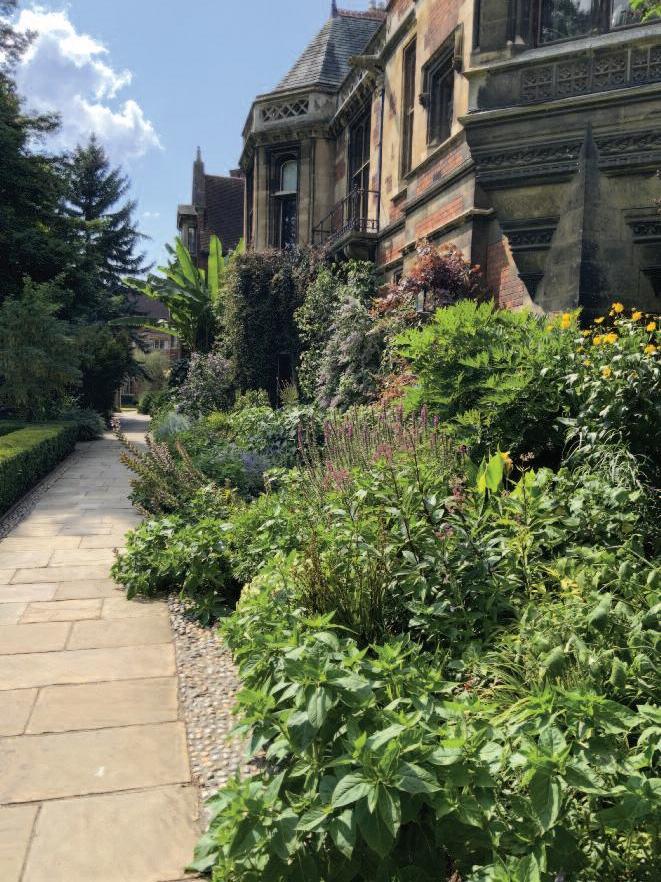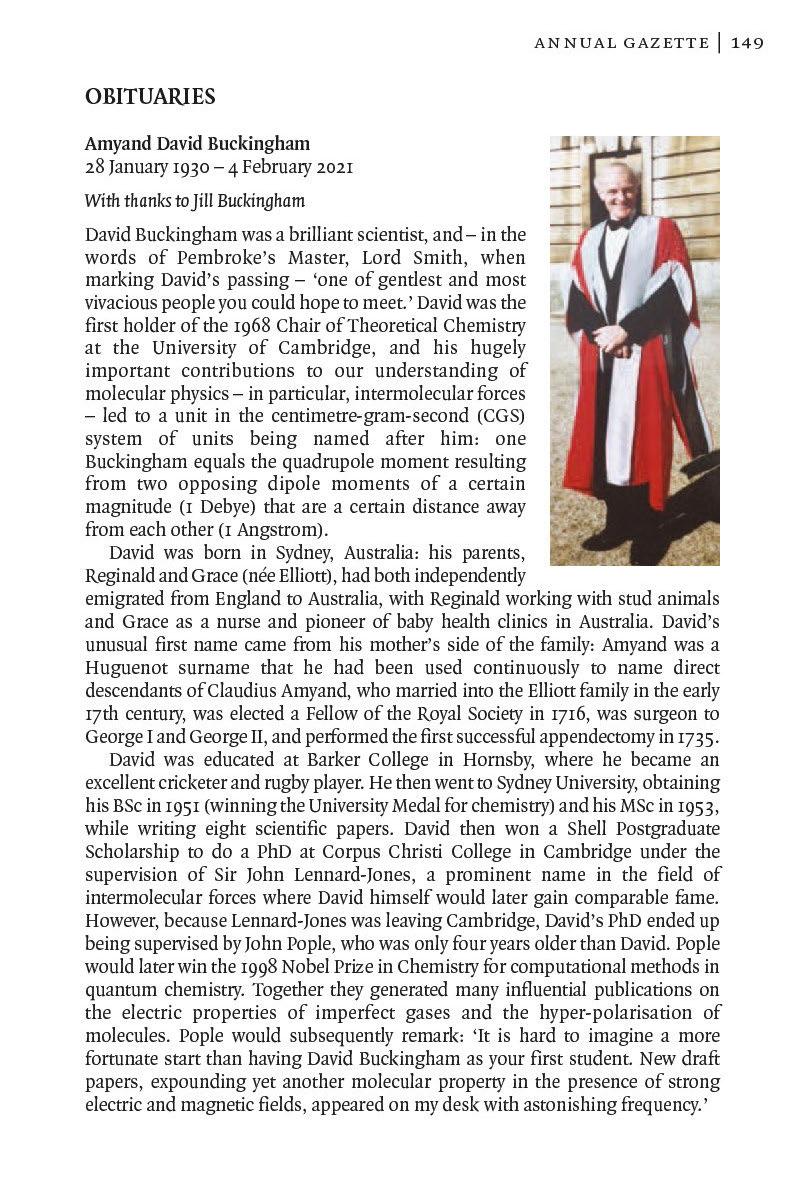
40 minute read
Obituaries
David completed his PhD at Corpus Christi in just two years, and he moved to Oxford in 1955, having been appointed as a Lecturer and Tutor at Christ Church. In 1958, David became a University Lecturer but remained at Christ Church. It was a fascinating time in the Common Room, with its being frequented by Robert Blake, Hugh Trevor-Roper, Roy Harrod, Lord Cherwell, George Pickering, the Dean Cuthbert Simpson, and WH Auden. One evening, Auden asked David what he was reading, and David told him about the Ukrainian physicist George Gamow’s book Mr Tompkins in Wonderland (1940), which explained how the universe would be affected by changes in the fundamental constants of nature. Auden was fascinated and asked if he could borrow the book. Nine months later, after an enquiry from David as to how he was getting on with the book, Auden put a poem in David’s pigeon-hole entitled ‘After Reading a Child’s Guide to Modern Physics’. The poem can readily be found on the Internet, or in collections of Auden’s poetry.
David’s researches on intermolecular forces continued and in 1963 he made an most important breakthrough working with Dr RL Disch of Harvard University on equipment at the National Physical Laboratory in Teddington: together they measured the electric quadrupole moment of carbon dioxide molecules. The following year, David met his future wife Jill Bowles, a physiotherapist. For several years, David had been going to the National Research Council in Ottawa for a six week spell each summer. In 1964, he decided to make the trip to Canada on the Cunard Liner ‘Franconia’. It was on board the Franconia that he met Jill, who was going to work on Vancouver Island. They were married in Oxford in 1965, just before David was due to leave Christ Church to take up his appointment as Professor of Theoretical Chemistry at the University of Bristol.
Advertisement
David’s distinction was such that after only four years in a vibrant department at Bristol, he was soon snapped up by Cambridge for its own chair in Theoretical Chemistry. This is what brought David to Pembroke College, becoming a Fellow in 1970. While at Cambridge, David’s work on the optical, electric and magnetic properties of molecules continued. David and Laurence Barron, who studied as a post-doctoral student with David from 1969 to 1975, did some exciting work on the Raman scattering of circularly polarised light, which led to the development of a whole new field of study, on vibrational optical activity. The practical applications of David’s research were manifold, and continue to be relevant to this day: advanced medical imaging techniques build on David’s work on nuclear magnetic resonance, while his work on nonlinear optical phenomena lies at the heart of modern-day fibreoptical telecommunications and laser technology.
David also did a huge amount of work supporting the work of colleagues in the Chemistry Department (including by supervising undergraduates, exceptionally for a University Professor), led hugely impressive research teams, and lectured the main quantum mechanics course at Cambridge for more than 25 years. This support was continued worldwide through David’s editorship of the scientific journal Molecular Physics from 1968–72, and in particular Chemical Physics Letters from 1978–99, with David sending hand-written letters to authors and paying meticulous attention to the detail of their articles. David’s editorship of the latter journal was very time-consuming as the journal was published weekly. As many as
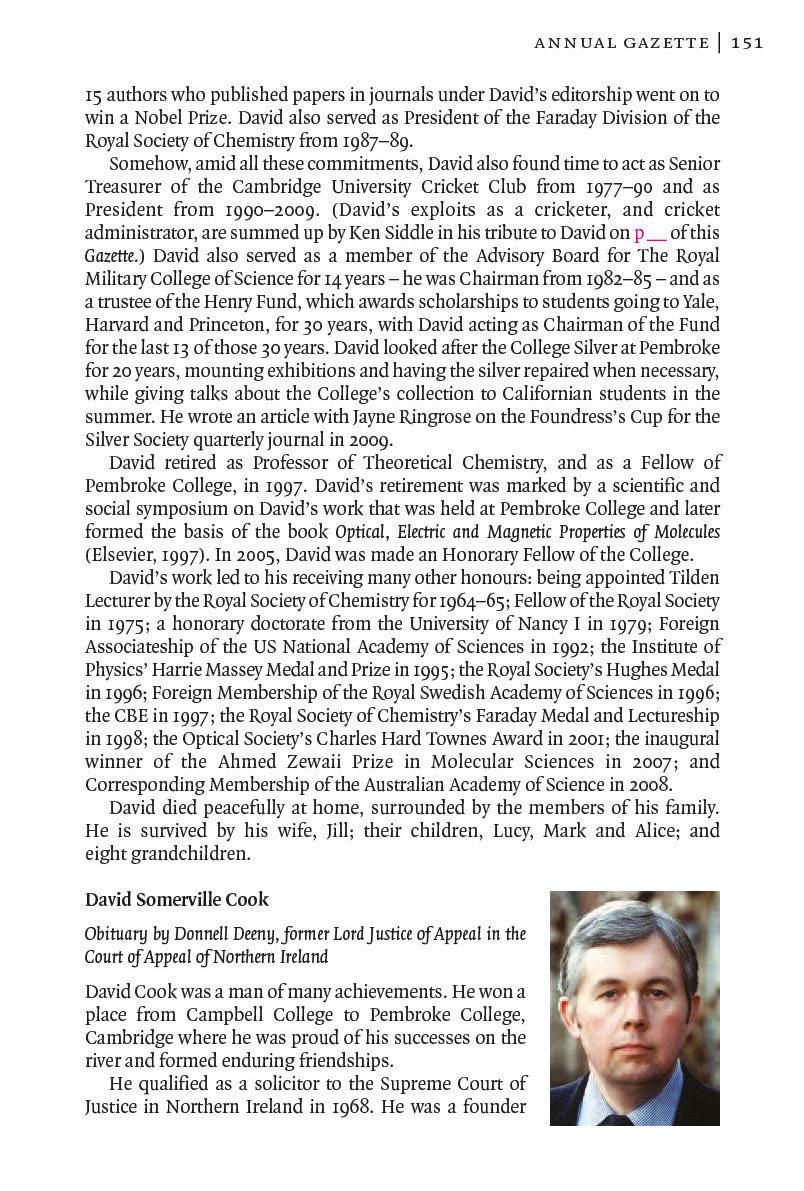
member of the Alliance Party and its Treasurer while in his 20s. He fought five successful public elections – three in succession to Belfast City Council, one to the Assembly in 1982 and most memorably his election as Lord Mayor of Belfast in 1978. He was the first non-Unionist to hold that office since the Liberal Viscount Pirrie in 1898. To achieve this end David assembled a remarkable coalition ranging from Unionists to Republicans and including the redoubtable Gerry Fitt.
It must be remembered that no local politician exercised power in Northern Ireland between 1974 and 1999 and so the city council was, for much of David’s time in politics, the major centre for political debate in the absence of a Stormont parliament. David and his wife Fionnuala (née Deeny) brought to the Lord Mayoralty inclusiveness, tolerance, generosity and style. The contrast was all the greater as the Troubles were still at their height. David was a beacon of liberalism in the darkest of times.
David’s courage deserves recognition. This is firstly in the physical sense, for the Alliance party headquarters was bombed and its leader had a police bodyguard. David was runner-up in a Westminster by-election in 1982 in South Belfast; it was held because the previous MP was murdered by the IRA.
When the British and Irish governments entered into the Anglo Irish Agreement in 1985 some councils including Belfast refused to strike a rate or discharge their statutory duties in protest. This process would have led to considerable hardship for ordinary people. David believed that these strikes should be challenged in the courts. His moral courage is manifest, because he brought the proceedings personally and would have had to pay the council’s legal costs if he had lost. Nor can his proceedings have been popular with all of his professional clients, given the milieu from which he came. In the event he won in the High Court before Brian Hutton, later Lord Hutton, who has himself passed away this summer. That decision was upheld in our Court of Appeal – vindicating David’s initial opinion – and we got our costs!
When politics ended for David with the proroguing of the Assembly in 1986, it seemed, to me at least, that he returned to practising law with pleasure. He was highly regarded professionally, particularly in the fields of probate and conveyancing.
He could not resist in 1994 accepting the offer of the chairmanship of the Police Authority although it was regarded by many as a poisoned chalice. So it proved to be in that his reasoned calls for reform to make the Royal Ulster Constabulary, as it then was, more acceptable to the community as a whole did not win favour with a majority of his colleagues and lead to a split on the Authority and his own departure from that office. David’s judgment was vindicated by the reforms implemented under Lord Patten only a few years later as a key part of the Good Friday Agreement.
David’s work spread over so many valuable and learned bodies that it is impossible to address them all but it is right to single out the Northern Ireland Voluntary Trust of which he was chairman for some 25 years. As Paul Sweeney says David’s appointment as the first Chairman was inspired. He raised millions
of pounds by his passionate advocacy and tireless efforts, millions which were then spent constructively and wisely in the support of the voluntary and community sector in this part of the world. David is survived by Fionnuala, their daughter Barbary, and their four sons, Johnny, Patrick, Julius and Dominic.
Hugh Burkitt (1963) writes: David didn’t just have gravitas. He had gravity. His reassuring solidity, his wonderfully deep resonant voice, his calm way of talking and his willingness to listen made him attractive. His physical presence drew people towards him.
When I met David at Cambridge 57 years ago he was playing the role of Falstaff . He was witty himself, but happy also to be the source of wit in others. Just like Falstaff he drank copious amounts of sherry and generously dispensed even larger quantities of it from his room on the ground floor at 5 Pembroke Street to anyone on their way into Hall.
I was particularly drawn to David because he wasn’t taking life too seriously. He was already a sophisticated member of the second year when I arrived as a freshman and I was easily led astray when he encouraged me to smoke and drink and chat rather than get down to my studies. Fortunately, the Boat Club had its own rather quaint set of training rules which kept me from complete moral collapse. For two weeks before a race we were ordered not to smoke and drink, to go to bed by 10.30pm and to get up for an early morning walk before breakfast in Hall. Fortunately the reward for this early rising strongly appealed to David and he led me on the path of righteousness – towards the special Boat Club Breakfast of double eggs and bacon.
I was delighted that Johnny’s appreciation of David’s life included among David’s serious political and charitable achievements, his proud boast of having won his Pembroke oar by achieving four bumps ‘All before Grassy’. This triumph was in fact a foretaste of David’s ability to apply his formidable leadership skills to knotty problems in politics. David had worked out that in his last year he was not going to be selected for the College first eight, but what he could do would be to row himself in a brilliant second crew. The plan was that it would make a triumphant four bumps while the Pembroke first eight was going Head of the River for the first time in over thirty years.
At that time the Boat Club ‘Heavies’ – our collective name for the leaders of the club – had little interest in the second eight because of their obsession with making the first boat go fast enough to go Head of the River. So David developed a year-long strategy. The first requirement was to recruit a whole new set of freshmen and persuade them to take up rowing. Then he had to teach them how to race in an eight and then he had to teach them how to make a bump.
At each stage the normally laid-back David applied prodigious quantities of energy and discipline to his task. He charmed eight innocent novices into coming down to the river; then for their first term he barked alternate encouragement and abuse at them from the bank; then he jumped into the boat with them in the second term; and finally in the May Bumping Races he wound them up to attack the enemy crew ahead of them on the river so fast and furiously that the poor chumps didn’t know what had hit them – until their crestfallen cox was raising
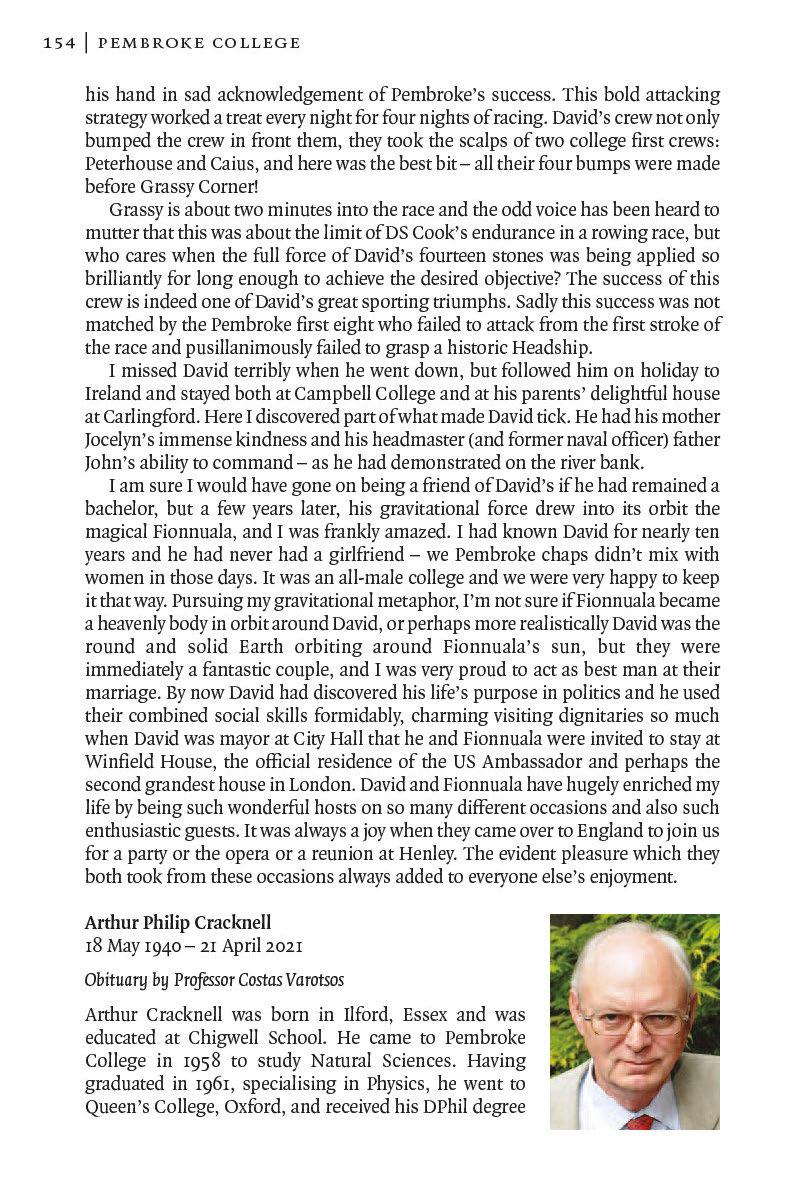
in 1964. Arthur began his career as a Lecturer in the Physics Department of the University of Singapore (now the National University of Singapore) and the University of Essex, moving to the University of Dundee as a senior lecturer in 1970. He was promoted to Reader in 1974, to Professor of Theoretical Physics in 1978 and was subsequently appointed to the Carnegie Chair of Physics in the Department of Applied Physics and Electronic & Mechanical Engineering.
Arthur’s early research was concerned with the determination of band structures and Fermi surfaces of metals, exploiting group theory to maximise the accuracy of calculations within the constraints of the computing facilities of the day. His interest in band structure led to the study of several other grouptheoretical problems in solid-state physics, with results published in about 80 papers between 1965–1980.
Of particular note is that his 1972 book with Dr C. J. Bradley The Mathematical Theory of Symmetry in Solids: Representation Theory for Point Groups and Space Groups was reprinted in 2010 as part of the Oxford Classic Texts in the Physical Sciences. The relevance of this theory is that symmetry has consequences for a variety of physical processes in, and properties of, crystalline materials. Subsequently, he was involved in extending the theory to cover magnetically-ordered solids. This led to the publication, with Dr B. L. Davies, of an extensive set of computergenerated tables of co-representations of magnetic (Shubnikov) space groups. This is now also a classic work in the field.
Arthur wrote several books during this period, including textbooks and substantial monographs on Fermi surfaces and symmetry in magnetic materials. Several of these books have since been translated into other languages, including Russian, Japanese, Polish, Spanish and Chinese. He also served for several years on the International Committee for the series of International Colloquia on Group Theoretical Methods in Physics.
Having established an international reputation in one field, Arthur’s personal challenge was to establish a reputation in another. In the mid-1970s his interests changed from the quantum mechanics of solids to the study of environmental issues and climate change using remote sensing, a field then in its infancy. This switch was prompted by the existence, on the one hand, of the satellite data receiving station that had been constructed in the former Department of Electrical Engineering & Electronics at Dundee University and, on the other hand, groups of academics across the university who were involved in environmental research and consultancy. In making this change his aim was to provide a link between the generators of satellite sensor data and the environmental scientists and engineers who were interested in their use.
In addition to the development and operation of the satellite data receiving station, Arthur sought to use remotely sensed data to obtain information about natural and anthropogenic environments which either could not be obtained by conventional in-situ methods or could be obtained more cost-effectively. His group was concerned with a broad range of quantitative remote sensing topics, including: • modelling Earth-surface conditions and atmospheric transmission properties,
• developing sophisticated software to facilitate the automatic and operational processing of remotely sensed data for the estimation of geophysical variables in near-real time, • calibrating space-borne instruments post-launch, and • developing airborne imaging spectrometers.
Arthur initiated and implemented a very extensive programme of summer schools between 1980–99, for which Dundee became famous throughout Europe and beyond. It is credited with advancing the use of remote sensing within the teaching and research of many academic, governmental and commercial organisations.
Arthur was particularly proud of his contributions to the study of imagery from the Advanced Very-High-Resolution Radiometer (AVHRR), a remote sensing instrument on the National Oceanic and Atmospheric Administration (NOAA) series of satellites. His 1997 book on AVHRR sensors and their associated data remains the definitive work on this topic.
Arthur was appointed Editor-in-Chief of the International Journal of Remote Sensing in 1983, just three years after its founding. In 2008, he stepped down as Editor-in-Chief, but continued to support the journal as Co-Editor-in-Chief, until the end of 2020. During his 37 years of working for the journal, it grew from a quarterly publication with an annual page budget of 500 pages, to a bi-monthly publication with an annual page budget of 10,000 pages. He personally contributed a significant body of research to the journal, including 130 research papers, reviews, and editorials. He was instrumental in the 2010 launch of a sister journal, Remote Sensing Letters, and also served on that journal as Associate Editor until 2021.
Arthur retired from Dundee University in September 2002. As Professor Emeritus, he authored, co-authored, or edited eight additional books and many special issues of the International Journal of Remote Sensing.
With his egalitarian principles, Arthur was a truly international scientist, believing firmly in a global scientific community that worked together for the common good. In his retirement, he continued to contribute actively to teaching and research, collaborating with institutes in China, Malaysia and Europe to promote science and scientists and to help give a voice to those who sometimes find it difficult to be heard in a western-dominated world. In China, Arthur helped hundreds of graduate students and young scientists in remote sensing at Nanjing University, Tsinghua University and the State Key Laboratory of Remote Sensing Science, by advising them on their research and guiding them in publishing their works.
The National and Kapodistrian University of Athens conferred an honorary doctorate on Arthur in June 2011. He was also awarded the Remote Sensing Society Medal in 1989; the Schwidefsky Medal of the German Photogrammetric Society/ISPRS in 1996; the Remote Sensing Society President’s Award in 1996. He was twice awarded the Medal of the Remote Sensing and Photogrammetry Society, the second time in 2017. He was a valued member of several national and international societies, committees, and working groups.
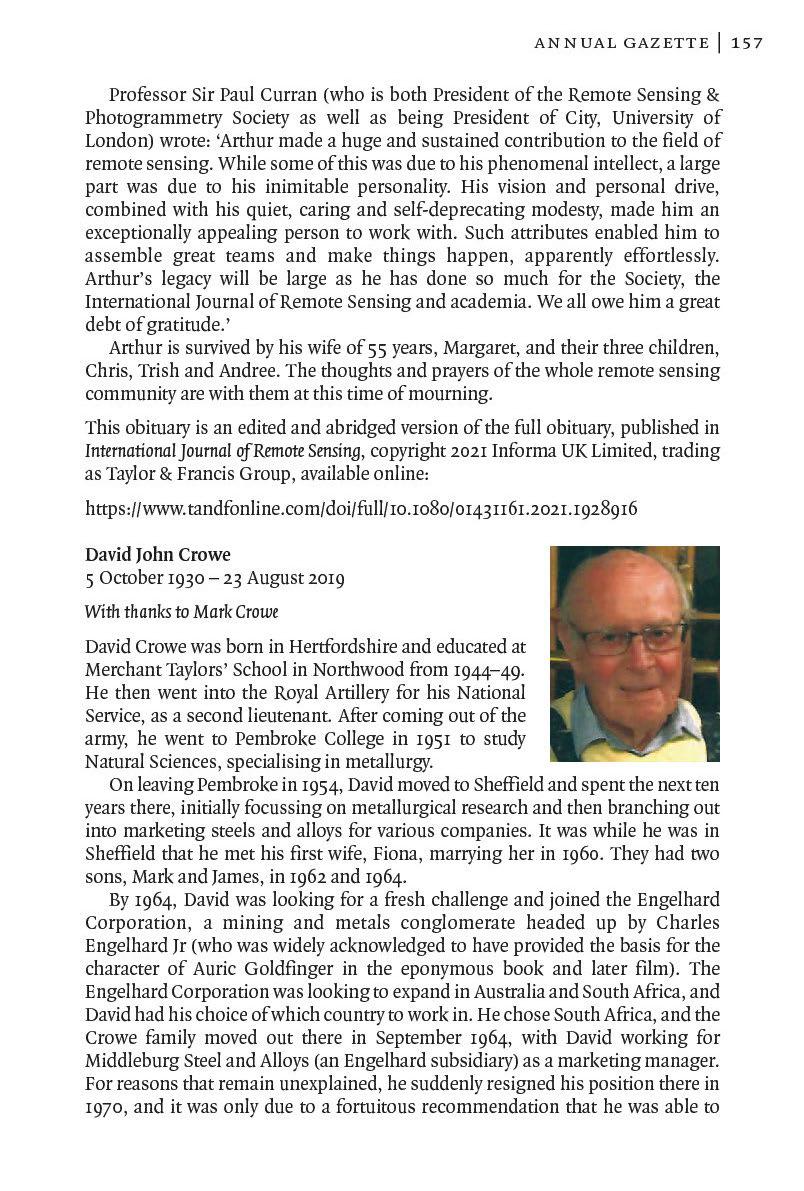
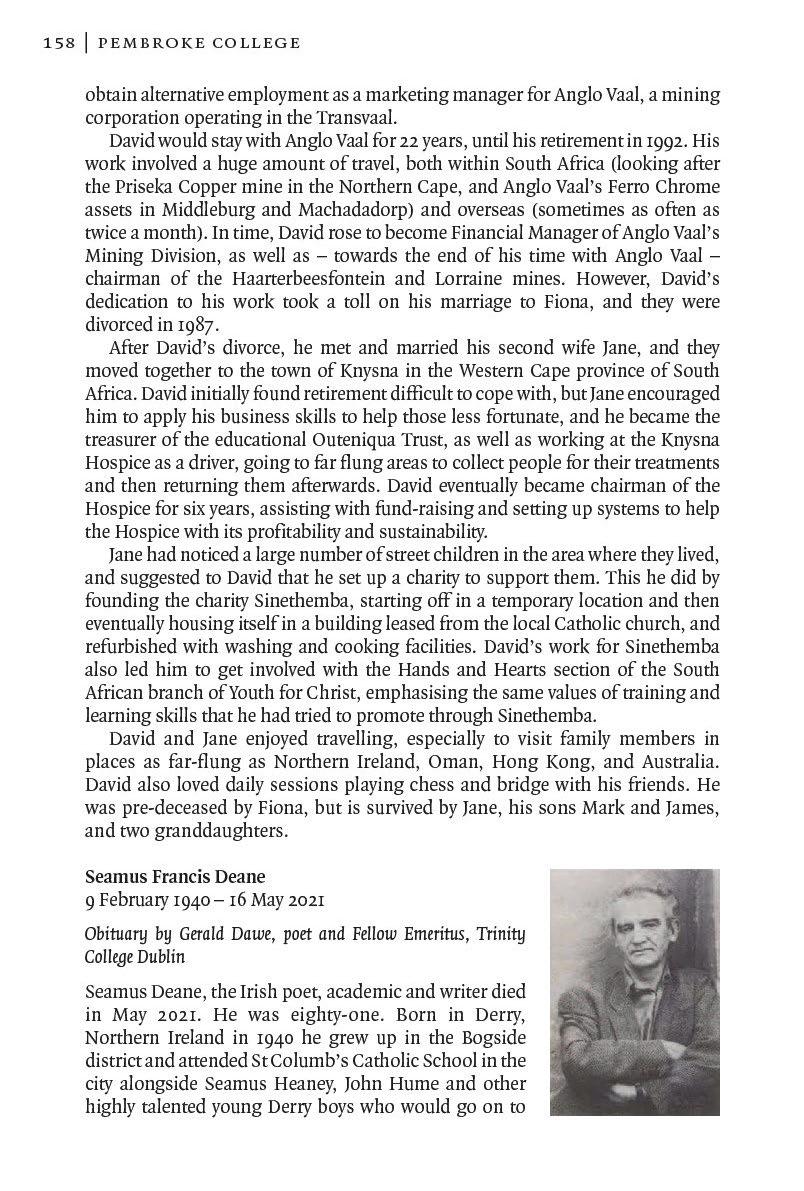
distinguish themselves worldwide as poets, academics and statesmen. Deane attended Queen’s University Belfast (1957–61) and Pembroke College Cambridge (1963–1968) and held visiting fellowships at Berkeley before returning to a lectureship at University College Dublin where he would become Professor of Modern English and American Literature and, subsequently, appointed Professor of English and Donald and Marilyn Keough Professor of Irish Studies at the University of Notre Dame, Indiana in 1993. He was also a leading figure in Irish literary and cultural life for many years, as one of the important influences behind The Crane Bag journal (1977–85) and of Field Day Theatre and publishing company responsible for what many consider to be a revival of Irish theatre and intellectual life particularly in the 1980s and 1990s when the country was experiencing some of the most damaging and tragic events of what became the ‘Troubles’.
Deane’s doctoral thesis at Pembroke College on ‘The Reception and Reputation of some thinkers of the French Enlightenment in England between 1789 and 1824’ was a crucial defining subject for his intellectual and political development. He saw Irish literature in the wider frames of European writing and was an early exponent of post-colonial theories which would find expression in the three volumes of the original Field Day Anthology of Irish Writing (covering 550 AD – 1988) of which he was general editor (a further two volumes devoted to women writing was published in 2002), and in the significant series of Clarendon Oxford Lectures he gave in 1995, subsequently published as Strange Country: Modernity and Nationhood in Irish Writing Since 1790.
His novel-memoir Reading in the Dark (1996) would reach a new and popular audience: it was short-listed for the Booker Prize and winner of several prestigious awards including The Guardian Prize and the Irish Times International Fiction Prize. A volume of collected essays Small World: Ireland 1798–2018 was published by Cambridge University Press shortly after his death.
I asked two of Ireland’s creative writers, one from the north, one from the south, to offer their thoughts on Seamus Deane and what he meant to them. Firstly, the novelist Eoin McNamee, director of Trinity Oscar Wilde Centre (TCD):
‘You felt that Seamus Deane had your back. That there was a steadying hand. I’m not much given to reading critical writing about the North and haven’t found much in what I have read but Deane knew when the intellect should defer to the art, and that if there was a risk to be taken you would be given a fair hearing when fair hearings were in short supply.’ And Thomas Kilroy, playwright and novelist, a long-standing friend of Deane’s from their time in University College Dublin (UCD) in the 1960s as he relates in this short eulogy written especially for the Gazette:
‘My relationship with Seamus was part friendship, part a passion for the use of language. The two became entwined. It began in the nineteen sixties when we were both trying to make academic careers in University College Dublin under the sharp eye of Denis Donoghue. I was six years older than Seamus but he was the teacher and I was the student. One of the revelations that he brought to me was the connection between the Irish literary experience and Europe.
‘We made several trips to Derry and he drove with me to my own home-place in
Callan. For the first time I became aware of the reality of the border. We had at least one chilling road-block, at night, on the streets of Derry. We were exchanging our different experiences of Irishness. We were seeking out one another’s parents. When
I met his father I was putting body on most of the Deane stories. I think he wanted to meet my father and mother because he knew that they were both active in the War of Independence, he, a commandant in the IRA and she, in Cumann na mBan, a stickwielding rustler of cattle from the estates of the East Galway landlords. ‘I was also a friend of some of those in the Field Day Company, with Deane, Brian
Friel, Stephen Rea and Seamus Heaney before I joined them on the board with
David Hammond and Tom Paulin. We were in and out of one another’s houses, talking excitedly about the great plans of Field Day. I know that Friel and Rea were anxious to bolster up the theatre weight on the board with another playwright, even one from the South, I think they were also conscious of the great engine of Deane steaming down the tracks beside them. Friendship was needed to hold it all together, with its rock solid base, its foundation of a shared understanding.’ One of Deane’s most sharply focussed and expressed views comes to mind: ‘[I]t is difficult to enter into the wider world without denying the inner world. It is not just an escape from nationality, of the British or the Irish variety; it is an escape into the belief that one is ‘free’, that one is the maker of the world he sings. I think this is a glamorous and vacuous notion’.
But the last word should go to Geraldine Meaney, fellow-academic, scholar and editor and a younger colleague for many years during Seamus Deane’s tenure at UCD:
‘It has been apparent since Seamus Deane’s death how much his teaching, thinking, and writing is part of the cultural and intellectual life of twenty first century Ireland. A great moderniser of literary criticism and the university teaching of English in Ireland, it seems as if every writer and half the journalists in the country attended at least one of his mesmerising lectures. Somewhere between a dramatic monologue and intellectual immersion therapy, whole new vistas on literature, philosophy and history could open out from a handful of well-chosen sentences.
‘The powerful opening lines of his 1972 poem ‘Derry’ have become iconic of the place, the Troubles, and Seamus Deane’s relation to both. Much of his later questing, questioning critical career is hinted at in the less familiar lines when ‘the mind’s eye/Perceives the ghost/of the hand’s try’ to summon a different future beyond the confines of a history of dispossession and violence. Reading in the Dark was a poet’s novel, as AS Byatt shrewdly commented, lyrical, poised, but also haunted, an eloquent examination of powerful silences. The quest to re-imagine the relationship between past and future was at the heart of the monumental Field Day Anthology of Irish Writing. It was typical of his intellectual integrity that when three volumes and 4,000 pages failed to adequately include women’s writing and traditions, he commissioned two more volumes and 3,250 more pages that brought nation and gender into dialogue. His critical legacy is an insight into the dynamic relationship of cultural production and national identities that has implications far beyond the ‘strange country’ which remained home on so many levels, despite his move to Notre Dame University in the 1990s.
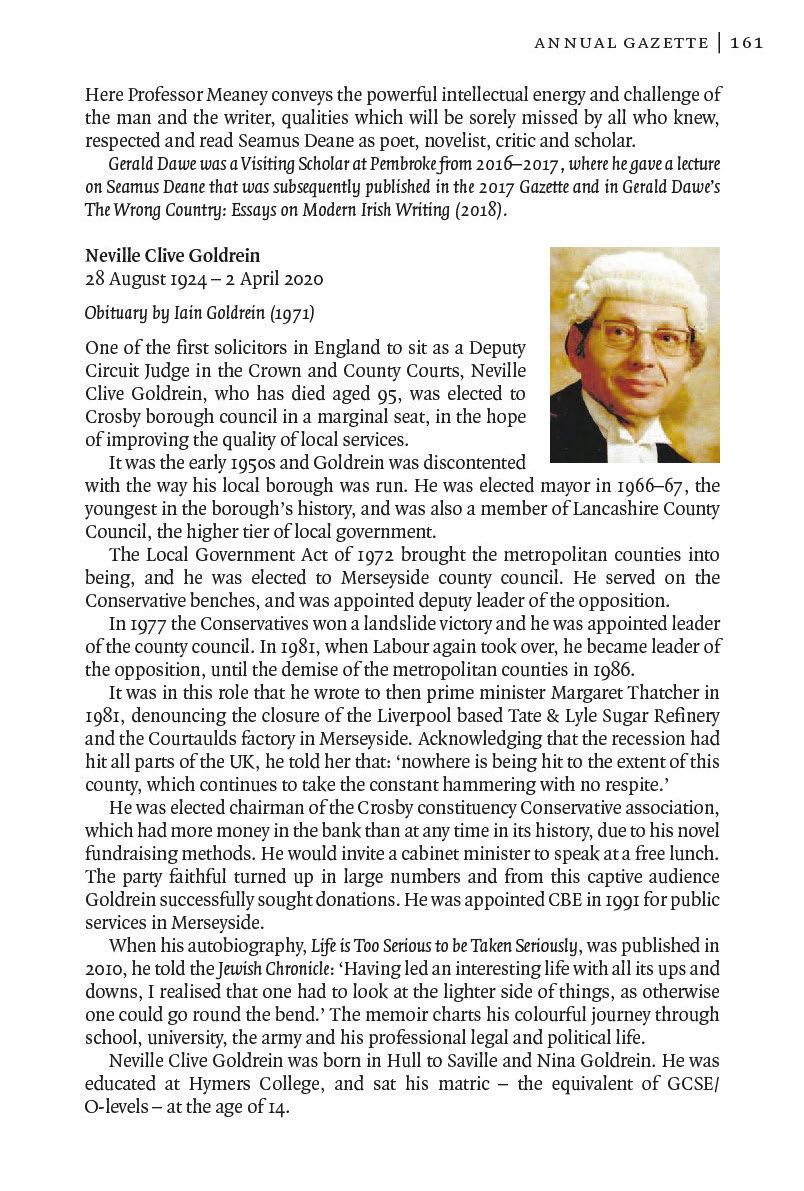
During the Second World War his school was evacuated to Pocklington, about 20 miles away, and he never forgot seeing his home town on fire during the blitz. He took his higher school certificate –the A-level equivalent –at 16, gaining a rare distinction. In 1942 he read law at Pembroke College Cambridge, achieving a 2.1 Honours degree at the age of 18, the youngest in his year. He was the college secretary of the debating society, a member of the Cambridge University band society –jazz was the current craze –and he played the saxophone.
Commissioned into the East Yorkshire Regiment, he was posted to East Africa in early 1945, and learned Swahili during the convoy journey out to Burma. He was sent to Italian Somaliland to serve in the Somalia gendarmerie, where his Swahili was vital. As he had Italian warrant officers he also taught himself Italian. He prosecuted for a time in the criminal court in Mogadishu, run by the British military administration, and then went to Villagio, a small Somali village, to command a company of Somali troops.
When his father died in 1946, he returned to the UK on a compassionate posting, serving the remainder of his time based in Liverpool, where the family now lived, as the adjutant at a transit camp. A mistaken phone call led to his coincidental meeting with a young doctor, Sonia Sumner, whom he subsequently married.
Demobbed in 1947 he took articles of clerkship and passed his solicitors’ finals after 18 months instead of the usual two years. He opened his own practice which grew into one of the largest firms in Liverpool with a staff of some 200. He was appointed a deputy circuit judge in the crown and county courts. Sonia, meanwhile, built up her own medical practice.
After retirement he attended lectures at the Liverpool University law faculty, purely for interest. His wife was busy with freelance journalism and doing locums for other doctors. He chaired various committees within the Liverpool chamber of commerce and also the Liverpool Royal Court Theatre, which was transformed from a derelict unheated barn to its original beauty, when first built in 1937.
He made video documentaries of the various holidays he and Sonia had taken. As Sonia already spoke fluent Hebrew, he decided to learn it as a language and not just as a means of prayer, and pursued its study with serious vigour.
He was a very committed Jew. As mayor of Crosby he insisted that all the banquets were kosher, and that his chaplain, Rabbi Stanley Wolfe, should make Hamotzi in Hebrew before formal dinners, which the mainly non-Jewish visitors clearly appreciated. He also held a special ceremonial service for aldermen and councillors at Princes Road Synagogue. He became warden and subsequently senior warden at Princes Road Synagogue, where he introduced the Sephardi pronunciation into the service –and continued to serve until 2011.
He was a member of various committees, including Shaare Zedek and The Technion, and the Liverpool Old Hebrew Congregation sub-committee and select committee.
He continued to hold senior positions at Princes Road and also the Southport Hebrew Congregation and was for some years a member of the Merseyside Jewish Representative Council. In 2004 he and his wife made aliyah, dividing their time between Liverpool and Jerusalem, where they bought a flat.
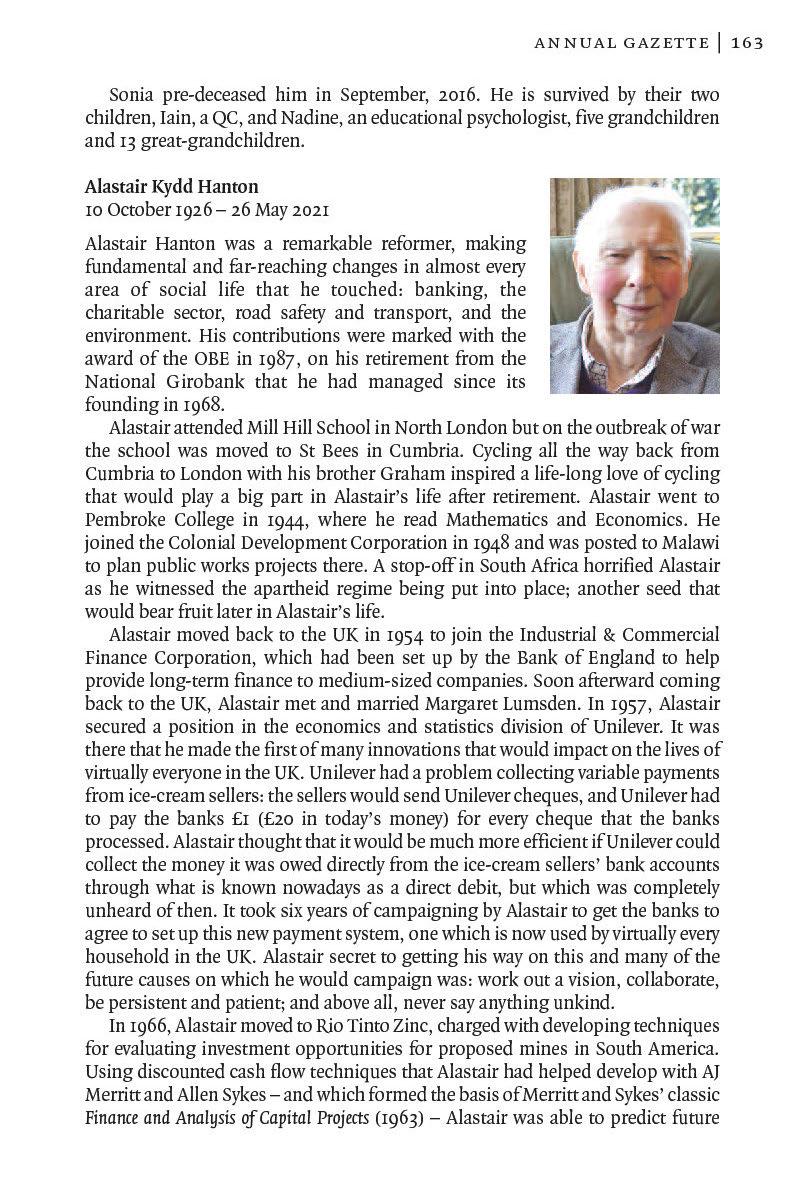
revenue from a given asset over time, and helped to make discounted cash flow techniques a fundamental tool for evaluating investment opportunities.
In 1968, Alastair sought and secured the position that would take him to retirement in 1986 – he was put in charge of the National Girobank: a national bank that the then Labour government set up through the UK’s network of 22,000 post offices, in order to provide a way of accessing banking services for even the most isolated communities. The National Girobank had an initially shaky start, making losses in its early years – and there was some suggestion that the new Heath government would shut it down. However, Alastair managed to turn things around and the National Girobank started turning a small profit. Alastair used his position at the National Girobank to transform the banking sector: where the National Girobank went, other banks were soon forced to follow. He not only introduced the concept of free banking but also the idea of interest-bearing current accounts. The National Girobank was the first to experiment with telephone banking, and its Link network of cash point machines allowed customers at other banks to withdraw money from Link machines.
Even before retirement, Alastair had started branching out into pursuing other causes. From the 1970s onwards, he became an assiduous road safety campaigner, targeting tax breaks for company cars (that were eliminated in 1992), bull bars on the front of cars, and lorries that were prone to knock pedestrians and cyclists over when reversing or turning left. He helped set up the Ethical Investment Research and Information Services (Eiris) which provided pension schemes and investment managers with information about how ethical the companies they were invested in were, and in particular on their degree of involvement with apartheid South Africa. Alastair joined the board of Eiris on his retirement from the National Girobank and continued to be involved in Eiris well into his 90s. The same year, Alastair also became vice-chair of Christian Aid. He used his connection with Christian Aid to combine forces with Oxfam and Cafod to set up the Fair Trade Foundation in 1992, which allowed supermarkets to label food and supplies as ‘fair trade’ so long as they guaranteed the producers of those products a good price for their products and a royalty on their sales.
Alastair was involved as trustee or chair in dozens of charities concerned with road safety and environmentally-friendly transport: the London Amenity & Transport Association, Living Streets, the London Cycling Campaign, Airport Watch, Campaign for Better Transport, the Foundation for Integrated Transport, the Environmental Transport Association. He campaigned to spread 20mph zones in residential areas, to memorialise road deaths so as to help planners identify and tackle particularly dangerous areas of road, and to install traffic calming and car-free areas in Southwark, where he lived. Alastair was such a familiar figure riding his bike around Southwark that Southwark Council used him as their ‘poster boy’ for their 2016 #cyclehappy campaign. The same year, Alastair was given a Lifetime Achievement Award at the Cycle Planning Awards.
Alastair is survived by his wife Margaret, their daughter Fiona, and their two sons, Angus and Bruce.
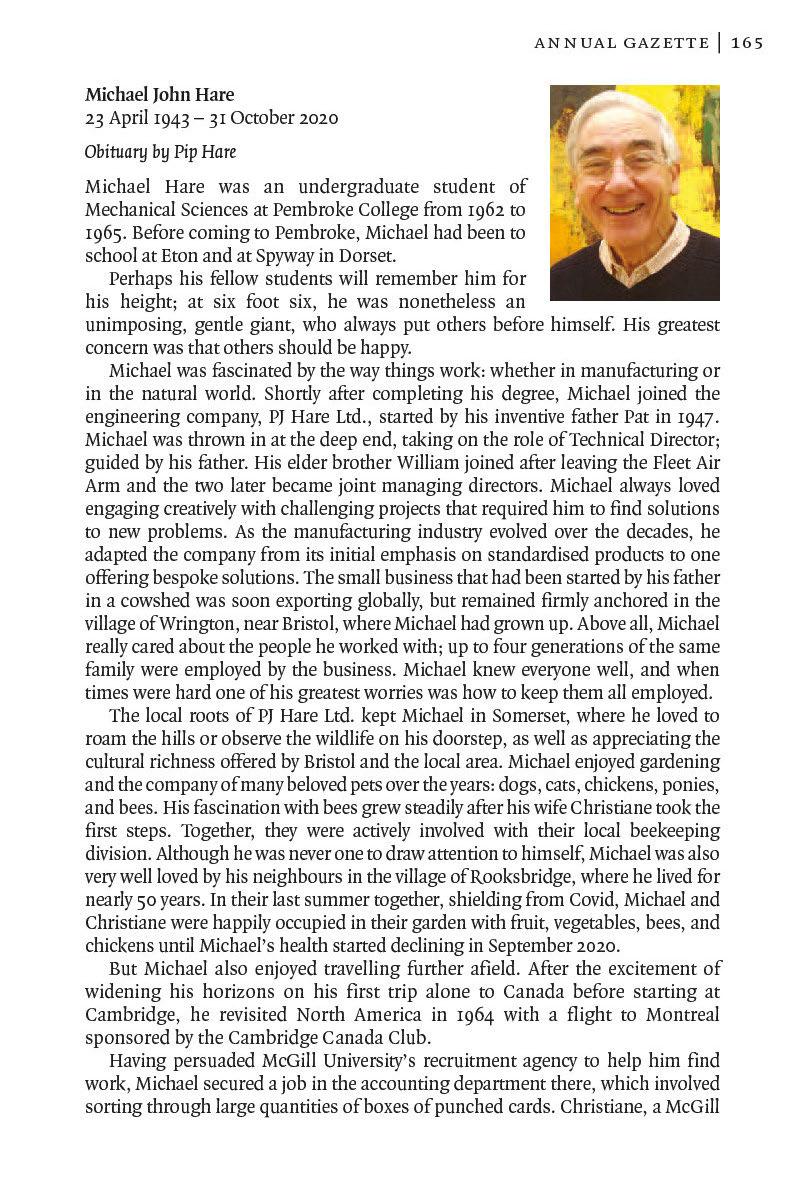
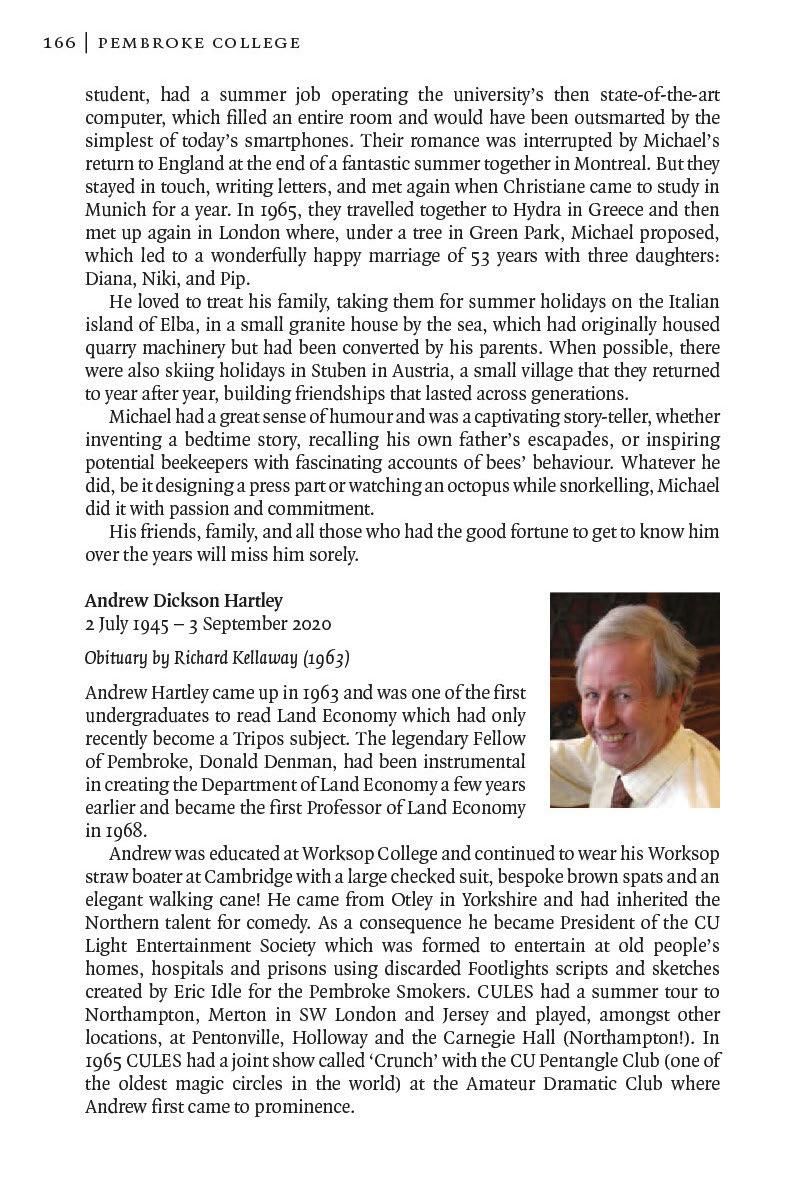
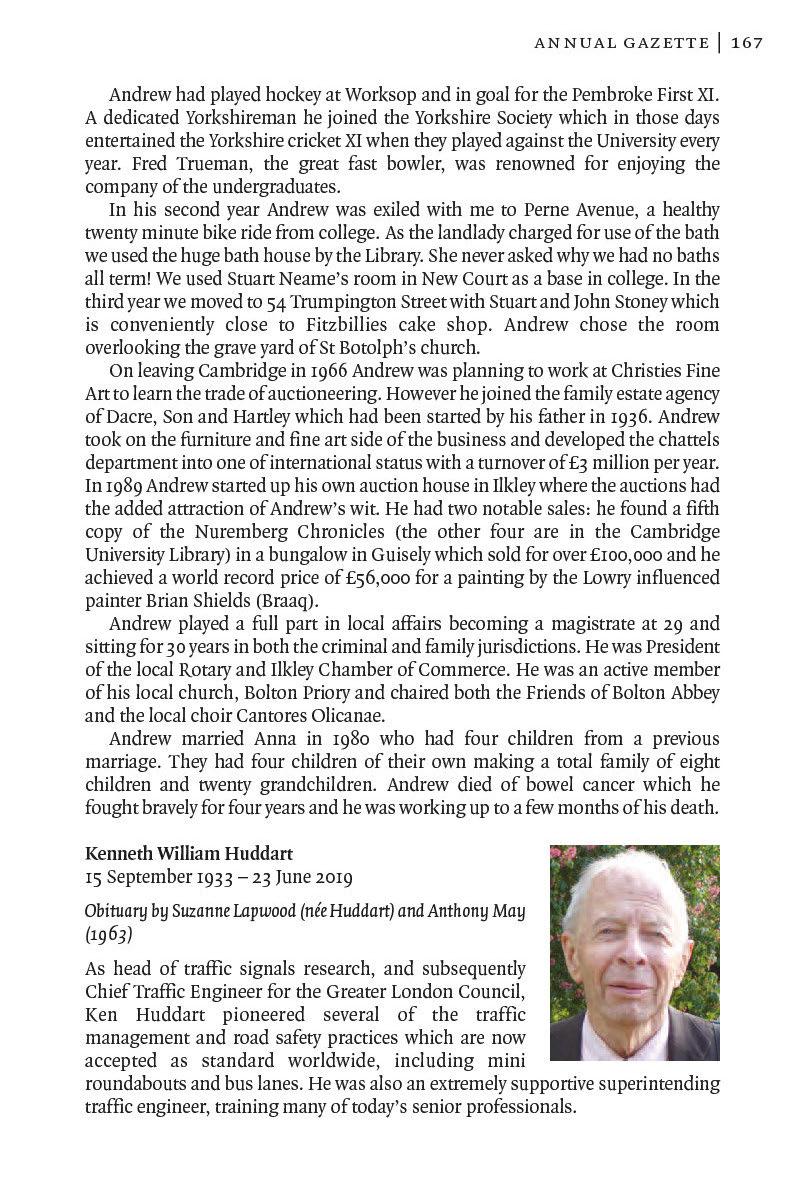
Ken was born in India and went to school there and at Harrow. He spent two years commissioned in the Royal Signals before going up to Pembroke College on a scholarship to read Natural Sciences (Physics) from 1954 to1957, graduating with First Class honours.
As an undergraduate, Ken occupied a set next to the then Dean, Rev Meredith Dewey. He was Student Secretary for the Pembroke Walworth Mission and also stayed there for a few months when he moved jobs to London after graduating. He continued to take a very keen interest in College, including attending an event at the Pembroke Mission not long before he died. While at Cambridge, he met his wife, Audrey Newboult (Homerton 1954–57). He was thrilled that his son David Huddart (1977) followed him to Pembroke. By a wonderful coincidence his granddaughter Anna Lapwood, as current Director of Music at Pembroke College, is now the third generation of the family to be closely associated with the College. Ken was moved when we gave him one of the Pembroke ‘memorial crosses’ shortly before he died.
After graduating, Ken worked at Reyrolle, Hebburn, leading nuclear and switchgear research, and then at Central Electricity Generating Board as system designer of the 500MW High Voltage Direct Current link from Kingsnorth to London. With the establishment of the Greater London Council in 1965, it became clear that engineering skills were needed in the emerging fields of traffic engineering, transport management and road safety. Ken rose to the challenge, and was appointed head of traffic signals research.
Ken rose to be Chief Traffic Engineer for London before the abolition of the GLC in 1986, and also acted as Greater London Officer for Road Safety. He contributed to systems improving traffic efficiency and safety across the world, including the introduction of urban traffic control, bus lanes and mini roundabouts in London and elsewhere in the UK. At the GLC he also launched an annual road safety campaign. One campaign ‘Isn’t your life worth a light?’ promoted the idea that all motorcyclists should ride with their headlights on at all times, which is now part of standard motorcycle design.
While at the GLC he welcomed professionals from around the world, and undertook traffic consultancy with the World Bank in Singapore, Madras, Manila, Calcutta, Mombasa and Baghdad. He taught traffic modelling in Northern Ireland, Israel, Zagreb and Australia.
After the abolition of the GLC he worked as a traffic engineering consultant, initially for The MVA Consultancy, including a new tram system in Hong Kong, where he was proud to have cured traffic queues at the Lion Rock Tunnel. He also introduced speed cameras in Lothian, a road safety audit in Israel and toll plazas in Poland, amongst many other projects. He was passionate about evidence-based road safety, for example playing a lead in the campaign to mandate the wearing of seatbelts, contributing to a major reduction in deaths and serious injuries.
As Peter Guest, who worked with Ken both at the GLC and with The MVA Consultancy, observed: ‘Ken was not without a sense of humour, but humour with an edge. Back in the 1970s I was attending a PTRC event where Ken was
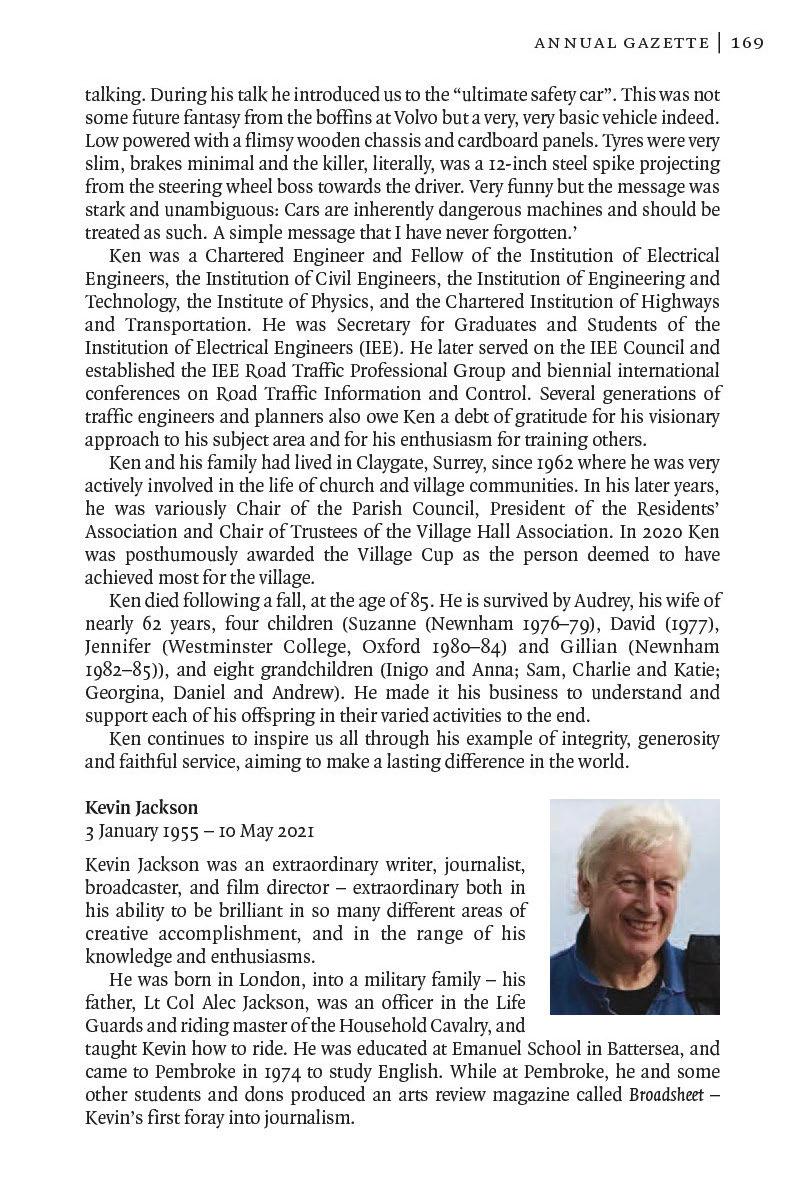
On graduating with a First in English in 1977, academia and the media briefly vied for Kevin’s talents. Kevin embarked on a PhD that went nowhere and in 1980 he took up a teaching position at Vanderbilt University in Tennessee. However, academia was too narrow for someone of Kevin’s vast array of talents and interests, and in 1984 he moved to London, working for the BBC on Radio 4’s arts programme Kaleidoscope and BBC2’s Saturday Review. The launch of the Independent in 1986 saw Kevin become the Independent’s arts editor – where he distinguished himself as being able at very short notice to supply high quality copy to fill gaps created by others who had failed to come through with pieces that they had been commissioned to write – and the Independent of Sunday’s film critic. Kevin continued to work for the BBC, directing in 1987 a documentary on Anthony Burgess – whose writings for the Observer Kevin had grown up on –called Burgess at Seventy that Burgess fans consider one of the best documentaries made about Burgess.
In the 1990s, Kevin made the leap to becoming a full-time freelance journalist. In his 2002 book London Orbital about travelling around London on the M25, the novelist Iain Sinclair described Kevin as the ‘freelance’s freelance’, burning up the hours on ‘essays in New York, reviews in London, radio, TV, presentation, production, small press squib, large press remainder’ and so busy that he had to compose a piece while going for a hike with Sinclair through the Surrey countryside. Kevin’s decision to go freelance resulted in an amazing stream of publications, including at least 30 books. There were books on cinema – Schrader on Schrader (1990), The Language of Cinema (1998), BFI monographs on Nosferatu (2013), Lawrence of Arabia (2007), and Withnail and I (2004) (a film very close to Kevin’s heart). There were acclaimed studies of Humphrey Jennings (2004), modernism’s annus mirabilis Constellation of Genius – 1922: Modernism and All That Jazz (2013) (a book described by Will Self as ‘that most counterintuitive of things, an insanely readable book about modernism’) and The Worlds of John Ruskin (2018). There were comic books (illustrated by Hunt Emerson): How to be Rich (2005), Dante’s Inferno (2012), How To See (2013), Bloke’s Progress: An Introduction to the World of John Ruskin (2018), and Lives of the Great Occultists (2020). There was a book for children in rhyming couplets: Greta and the Labrador (2019). There was poetry: an English translation of the Polish poet Adam Mickiewicz’s Crimean Sonnets (2015) and an edited collection of Anthony Burgess’ poetry, Revolutionary Sonnets (2002). There were books that reflected Kevin’s quirky, exuberant genius: Invisible Forms: A Guide to Literary Curiosities (2000), Letters of Introduction (2004) (A–Z treatments of ten writers and two themes), A Ruskin Alphabet (2004) (the same A–Z treatment, but just for John Ruskin), Moose (2008) (a study of the animal that Kevin was nicknamed after, with his home in Linton, Cambridgeshire, being named ‘Moosebank’), and Bite: A Vampire Handbook (2010). The last resulted in Kevin getting into film production: he commandeered the publicity budget allocated for the book by its publisher and used the money to produce, with the musician Colin Minchin, a short film called Bite: Pavane for a Vampire Queen. The film was credited to Alces Productions (‘alces’ is the genus of mammals covering the moose and the elk) and further short films would be produced by Alces.
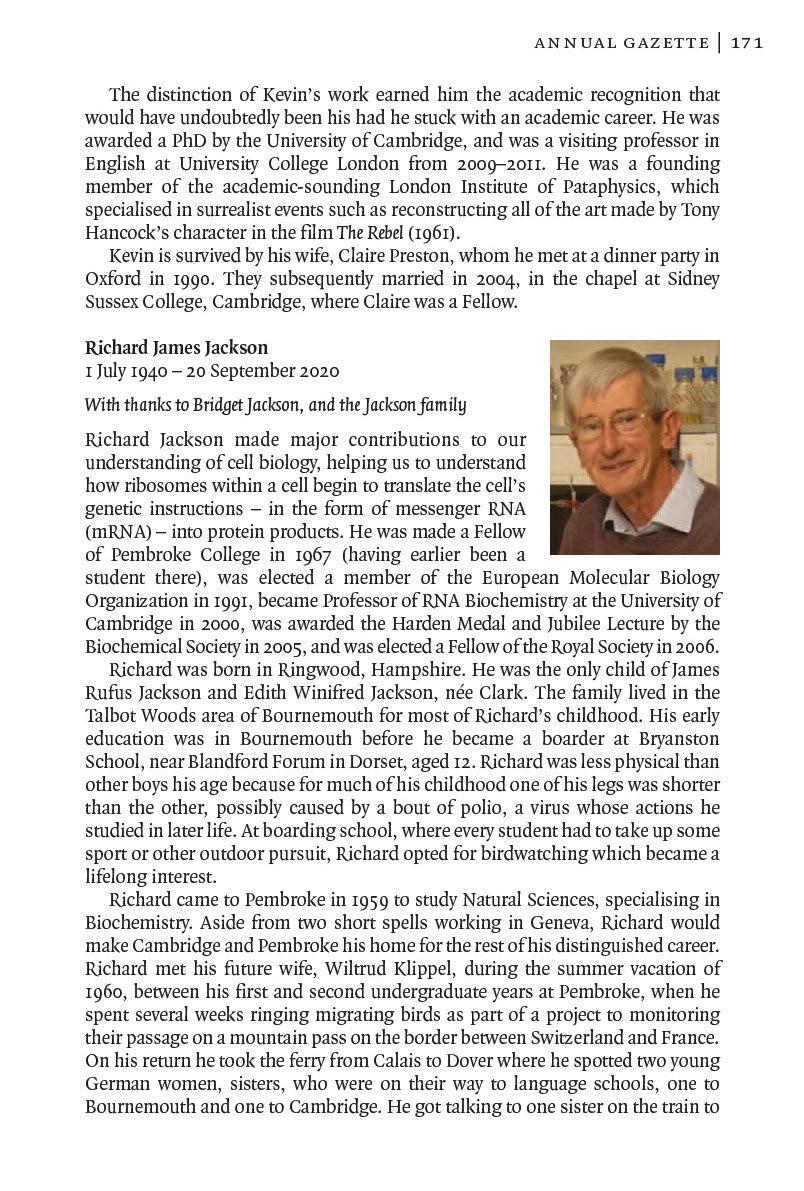
Bournemouth, who gave him the details of her younger sister so he could contact her when he returned to Cambridge. When back at University, he wooed Wiltrud, the younger sister, with invitations to student parties, and feasts of Fitzbillies coffee and walnut cake.
Having graduated in 1962, Richard then undertook a PhD under the supervision of Asher Korner. The focus of Richard’s PhD was measuring the number of transfer ribonucleic acids (tRNAs) per active ribosomes in a cell. In the course of doing so, Richard also discovered a particular type of ribosomal RNA molecule, known as 5S RNA. Richard obtained his PhD in 1966. Never one to do things by halves, Richard’s thesis was no different: it consisted of a two volume work that led to a university edict that in future PhDs in the sciences should not exceed 50,000 words.
Having obtained the PhD, Richard took up a position as Resident Fellow in the Department of Molecular Biology at the University of Geneva, working with Alfred Tissières. He also married Wiltrud in October 1967. After a year, Richard returned to Cambridge, taking up a Research Fellowship at Pembroke.
In 1970, Richard made a major breakthrough with Tony Hunter (whom he had met while working on his PhD), publishing a joint paper in Nature that established that that in eukaryote cells the initiation of protein synthesis is primed by a methionine amino acid supplied by a specialized tRNA. As a result, he was made a University Demonstrator (a Junior Lecturer) in the University of Cambridge, becoming a full Lecturer three years later in 1973. 1970 also saw Richard begin a 15 year long collaboration with Tim Hunt – again, someone he had first met while working on his PhD – on the regulatory steps governing protein synthesis. After Tim Hunt left Cambridge, Richard’s research began to focus on ‘internal ribosome entry segments’ (IRESs) that enable ribosomes directly to initiate translation of cellular and viral mRNA into protein products. But Richard and Tim Hunt would collaborate one more time at the start of the 1990s on developing a coupled transcription-translation system using T7 RNA polymerase.
Richard loved designing a clever experiment and working out its implications, so it is not surprising that one of his most significant contributions was technical in nature. In 1976, Richard and his PhD student Hugh Pelham developed the widely used reticulocyte lysate system which enabled in vitro investigations of the mechanisms of translation. In those more innocent days, Richard did not consider patenting the system. The assay became an invaluable tool for investigators seeking to link genes to their protein products and remains a standard toolkit in many molecular biology labs.
As a Director of Studies at Pembroke, Richard was a particularly astute and valued interviewer. He believed in fairness, equality and merit, and would spend a long time preparing for interviewing, pouring over each candidate’s background and comparing average school results to find those candidates who had achieved over the odds. His brilliant statistical analysis of the large and varied candidates that the College attracted was much missed by his colleagues when he retired.
Aside from the stress of battling the Cambridge traffic to get in on time for 9am lectures, Richard greatly enjoyed his work. He particularly enjoyed

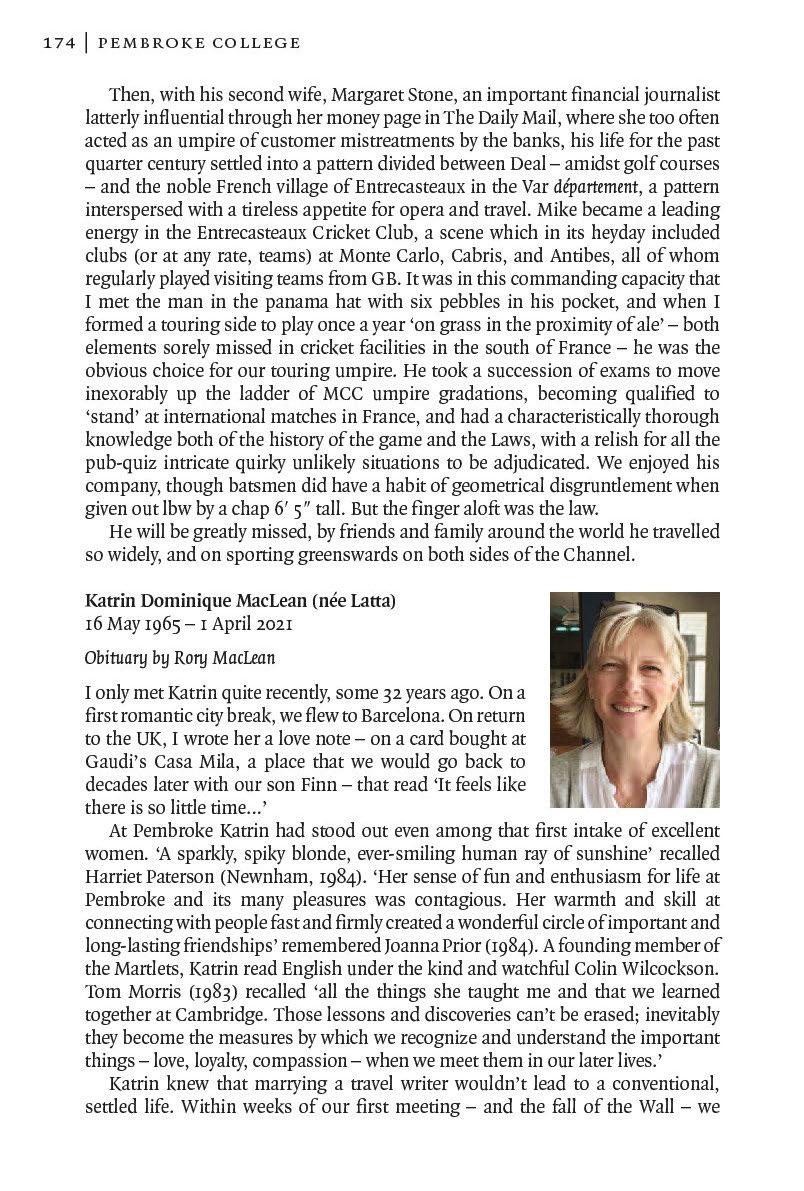
travelled from Berlin to Moscow, making the journey that would become my first book, Stalin’s Nose. In 1989 Eastern Europe was in a state of euphoria and we met people who opened their hearts and told us their stories, drawn out in part by Katrin’s light touch, engagement and positivity (as well as fluent German and French). In the course of researching further books, we rode shotgun with an armed Burmese hill tribe warlord, met Aung San Suu Kyi in Yangon, canoed across parts of Canada and hand-build a feather-light flying machine that would lift me into the blue Cretan sky. After our wedding, attended by bridesmaids Joanna Prior and Christine Gettins (1984), Katrin wrote thank-you letters aboard a container ship in the mid-Atlantic. We lived on Mull, in the Cairngorms, London, Tuscany and Berlin before finally settling in rural Dorset. Our home gave us a door that we could close behind us, and we did time and time again, even after the birth of our son. We three hot-air ballooned over the Nile, slept in a mud hut in Sri Lanka, hummingbird-watched in Texas, ate horse tenderloin with Arctic thyme glaze in Iceland, and every summer on West Country walks collected wild elderflower for her to make her divine cordial. My solo travels came to be squeezed in between family milestones. After surviving a nerve-wracking road trip across Afghanistan, I rang home to announce that I was still alive. ‘And Finn can walk!’ Katrin called down the line.
For 32 years we were all but inseparable, and not only because Katrin edited my every book with astute insight. Together we wrote Gift of Time about the striving for una bella morte – a good death – after my mother’s battle with cancer. And alongside shared adventures, she explored her individual gifts: becoming an innovative basket maker years before the craft was recognised as an art, reinventing herself as an Alexander Technique teacher, embracing photography as a late passion, capturing patterns, symmetries and colours of the natural (and in Berlin unnatural) world.
Then at the age of 55, within two years of her parents’ deaths, cancer came out of nowhere. Its diagnosis may have been delayed by the restrictions of the first pandemic lockdown but the shocking speed of its growth wouldn’t have changed the outcome. Katrin stood up to it, declaring out loud that she didn’t invite it into her body, emboldened by the M¯aori affirmation kia kaha, meaning stay strong. Yet after a false dawn of successful treatment, she passed away at home in her sleep, peacefully, with me holding her hand and telling her that she is so loved.
To some of us, 32 years may seem like a long time, but it isn’t and wasn’t. Katrin was taken much too soon, cruelly soon – yet for more than 32 years she lived with a gentle firm intensity, not wanting to waste a minute, as if indeed she too sensed that there truly was ‘so little time’. She embodied so many glorious qualities: her calm and measured voice, full of warmth and empathy, that could suddenly bubble into ribald laughter; her genuine smile, clean soul, clear heart and sparkling eyes, always looking, really looking, noticing, remembering, asking, caring; the joy and incredibly brightness she brought into a room; her immeasurable love for Finn; her untiring focus on what was beautiful, on possibilities. Every suppertime over our years together she lit candles, taking it all in, making the meal a special ritual, finding a home in us. ‘Life is not measured
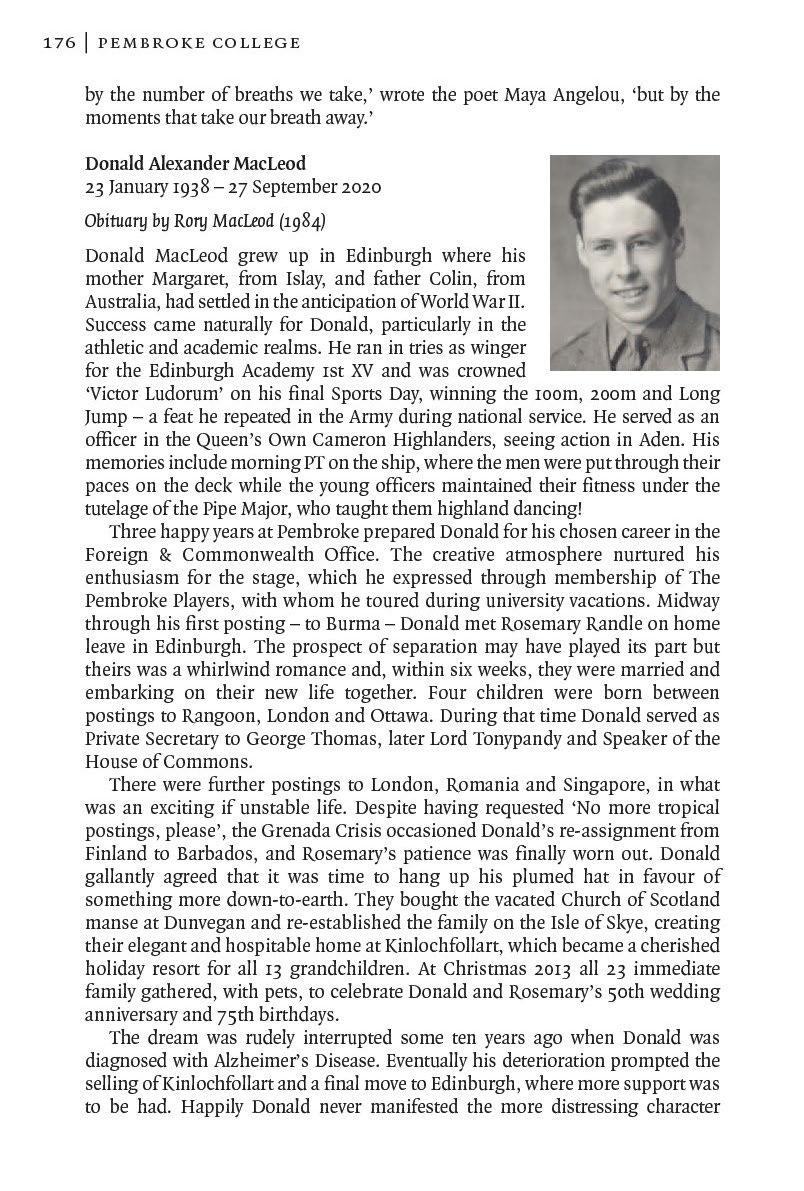
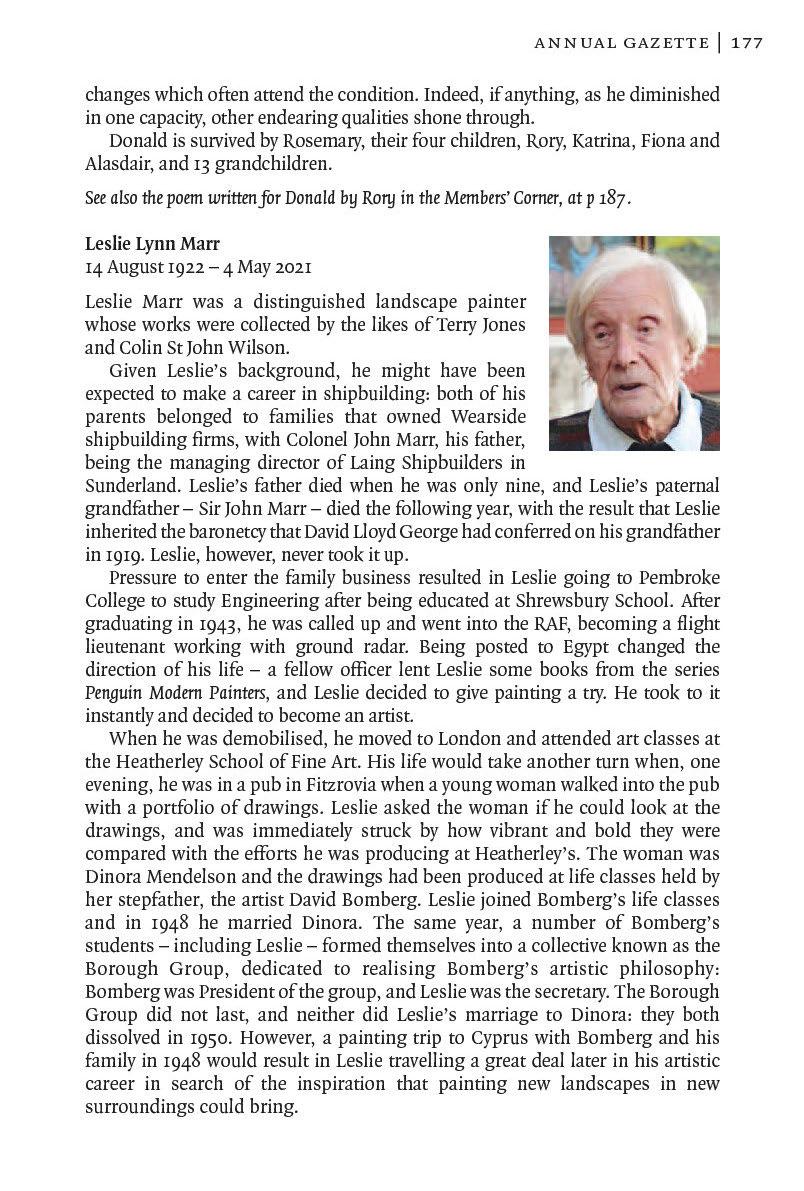
But the initial result of the collapse of the Borough Group and his marriage was that Leslie took a step back from painting and turned to a new pursuit: car racing. He eventually became good enough in the sport that he competed in two Formula One grand prix races in 1954 and 1955, coming 13th in the first and being forced to drop out of the second because of damage to his car. A photographer captured Leslie’s car leading Stirling Moss’s and Juan Manguel Fangio’s Mercedes cars into a bend, though Leslie would readily and ruefully admit that he wasn’t on the same lap as they were. 1954 also saw Leslie make his movie debut alongside Stirling Moss in the racing movie Mask of Dust. By 1956, Leslie realised that despite some successes in car racing – first place in the 1955 Cornwall MRC Formula One Race, and fourth in the 1956 New Zealand Grand Prix – he was pushing his luck by continuing to race, and a crash at Invercargill in New Zealand led to his retirement as a racing driver, much to the relief of his mother who would stay in bed when he was racing and wait for his call to confirm he had not been killed.
After a detour into film-making – producing a documentary about detergents for Unilever in 1956 that won best documentary at a Belgrade film festival (Leslie presumed his must have been the only entry) and a documentary filmed in Lapland in 1957 about reindeer migration in temperatures of about -40°C – Leslie returned to his first love: art. In 1961, he moved to New Zealand, living alone in a small fisherman’s hut by Lake McKerrow, living on trout that he would catch from the lake, and developing his talent as a painter. In 1962, Leslie married Lynn Moynihan, with whom he would have two daughters, Joanne and Rebecca. They initially lived in Devon, where Leslie would paint while also teaching in Barnstaple. In 1969, they moved to Norfolk, which inspired Leslie to produce paintings of the local churches and flowers. However, he would also travel with Lynn around Britain, the Mediterranean and New Zealand, and they spent six years on the Isle of Arran.
After 36 years together, Leslie and Lynn’s marriage was dissolved in 1998 and the following year, Leslie met Maureen Dormer, a former actress who would become Leslie’s third wife in 2002. Leslie and Maureen settled in Gillingham, Norfolk but continued to make expeditions to far-flung places for Leslie to paint. In 2012, Leslie’s work was celebrated with an retrospective exhibition at the Piano Nobile gallery in London, under the title Leslie Marr at 90. He continued painting until the last year of his life.
Leslie is survived by Maureen, his daughter Joanne (Rebecca died in 2016 from breast cancer), and three grandchildren.
Ralph Nicholas Quartano
3 August 1927 – 1 January 2021 Obituary by Kate Quartano Brown Ralph Nicholas Quartano was born in 1927, the only child of a Greek civil engineer from Corfu and an Australian-Scots champion golfer. At prep school during the war he cleaned rifles and made Molotov cocktails for the Home Guard.
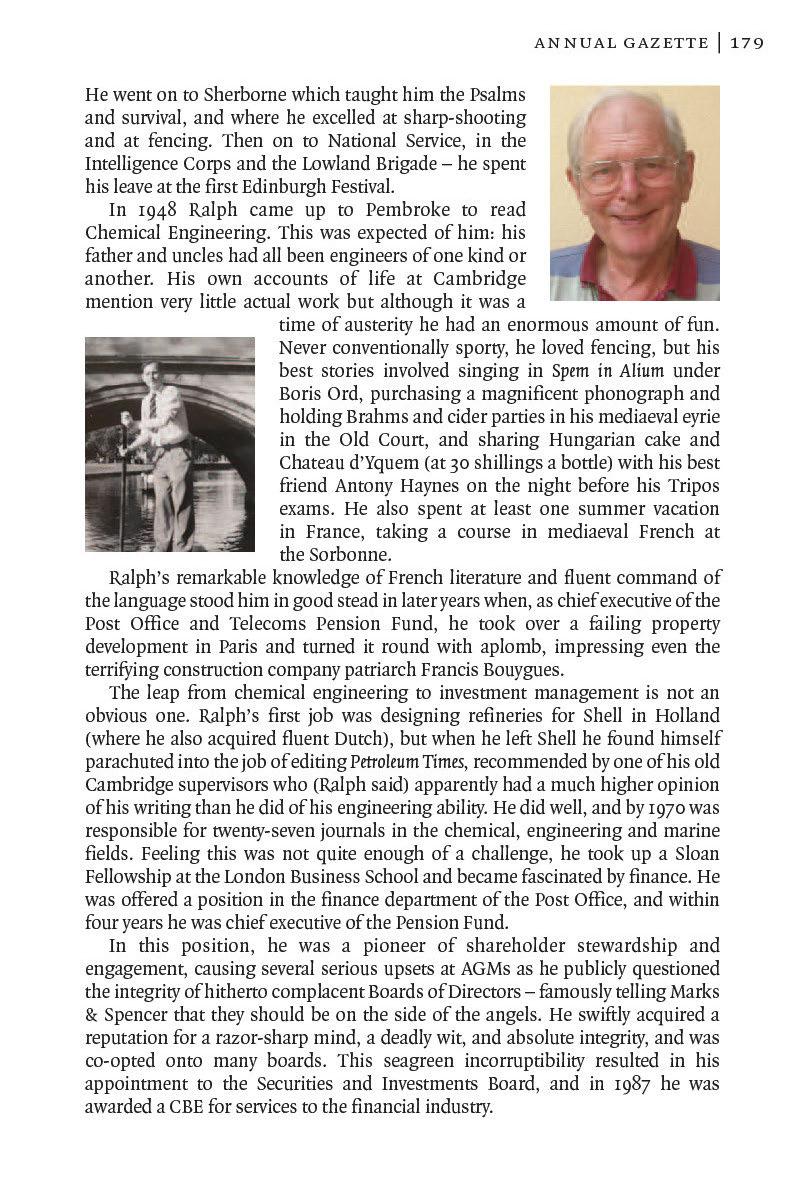
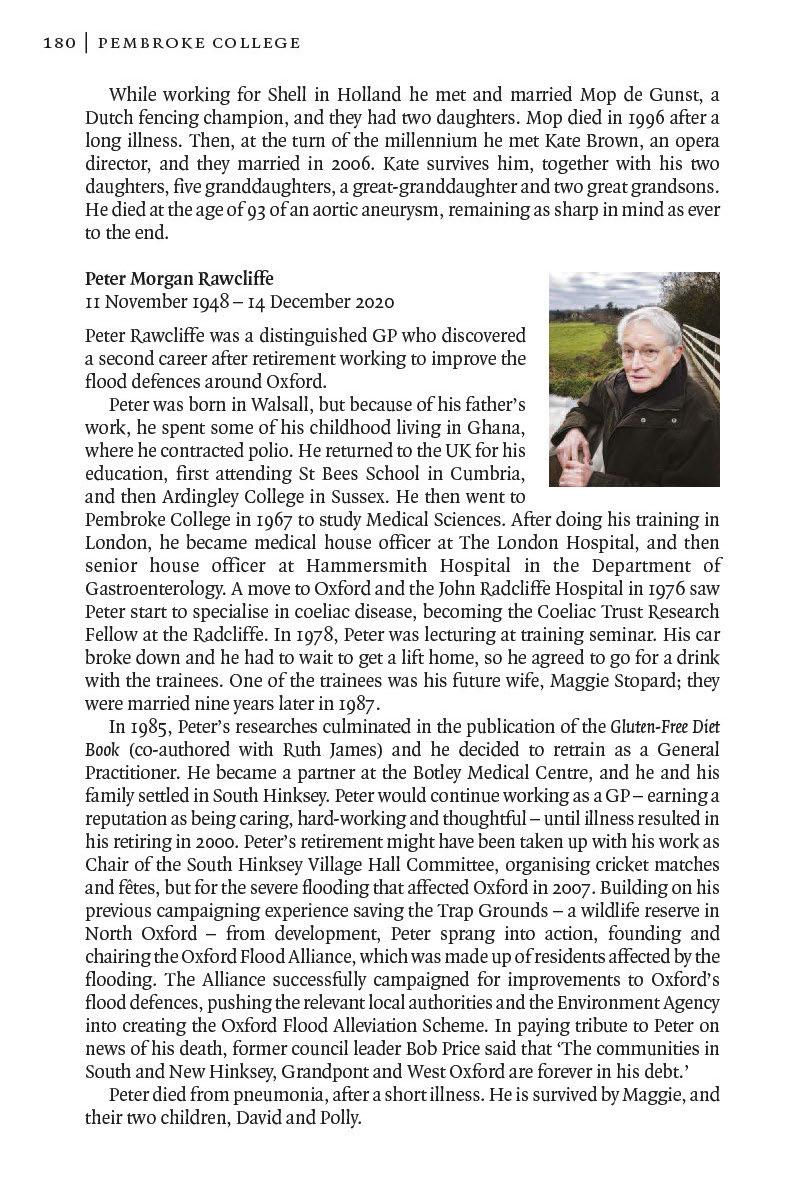
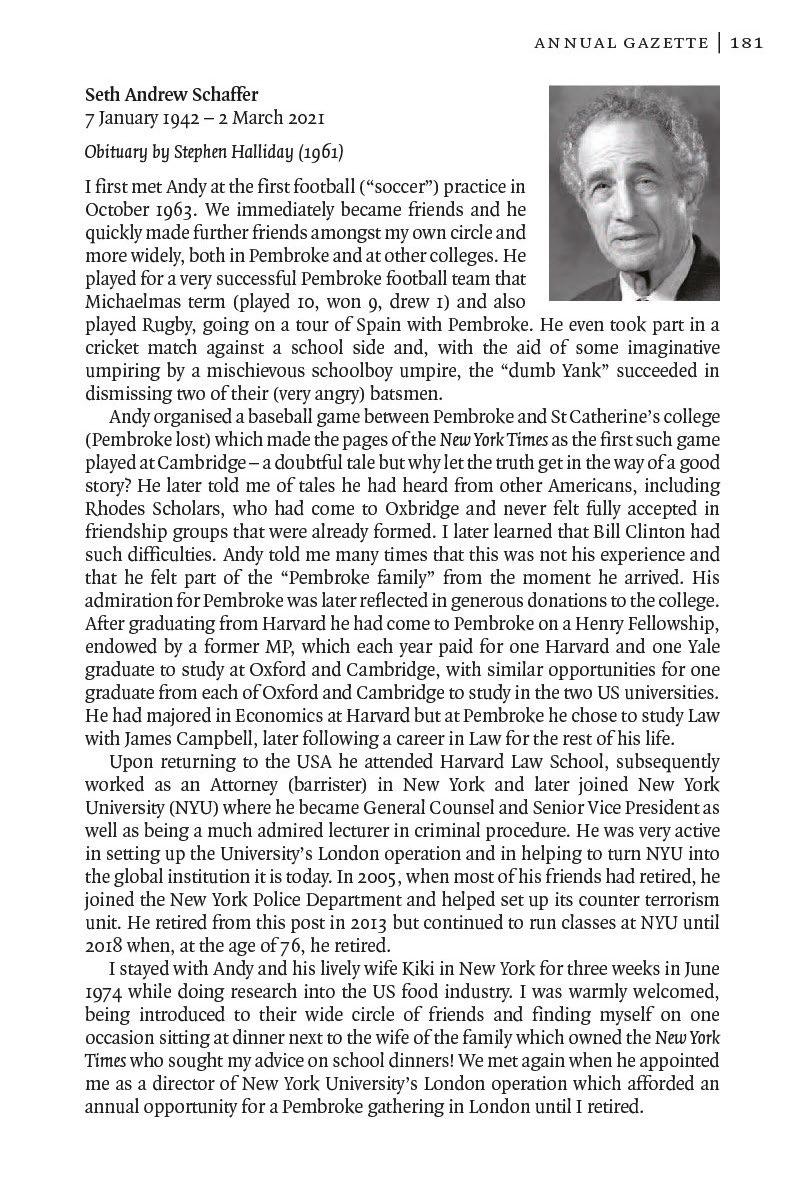
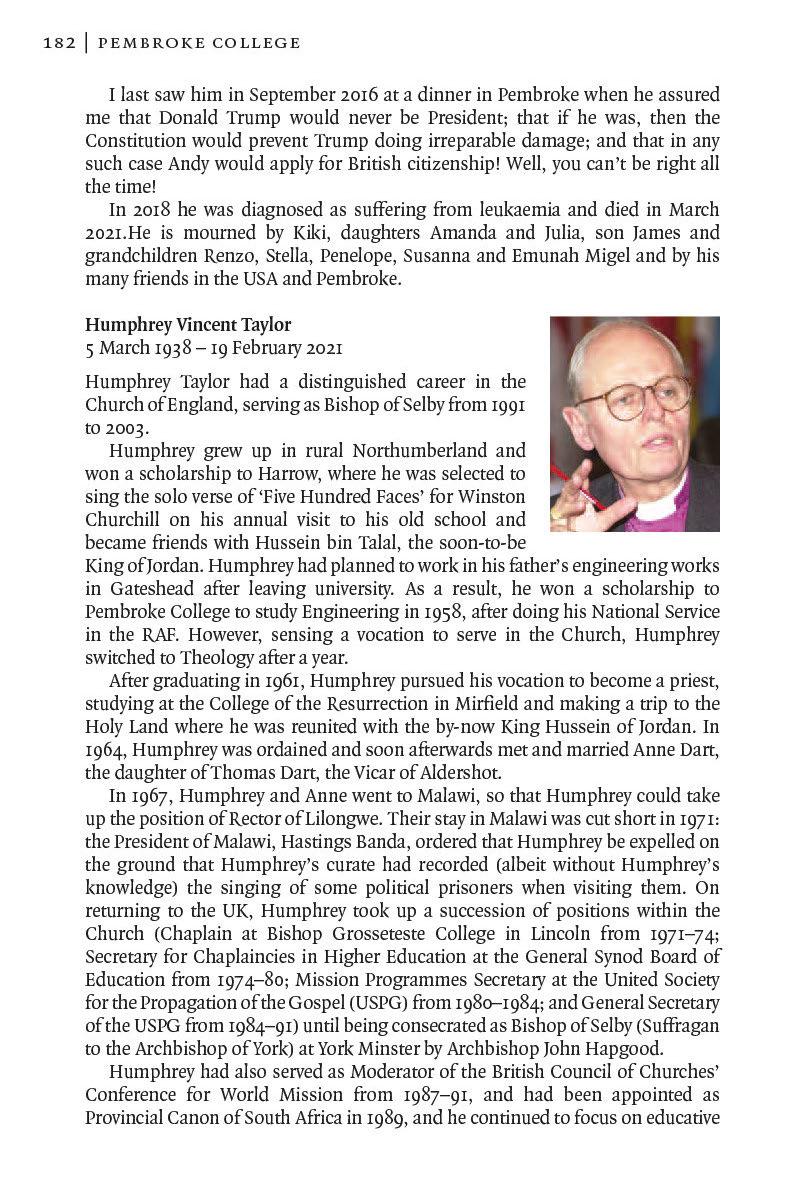
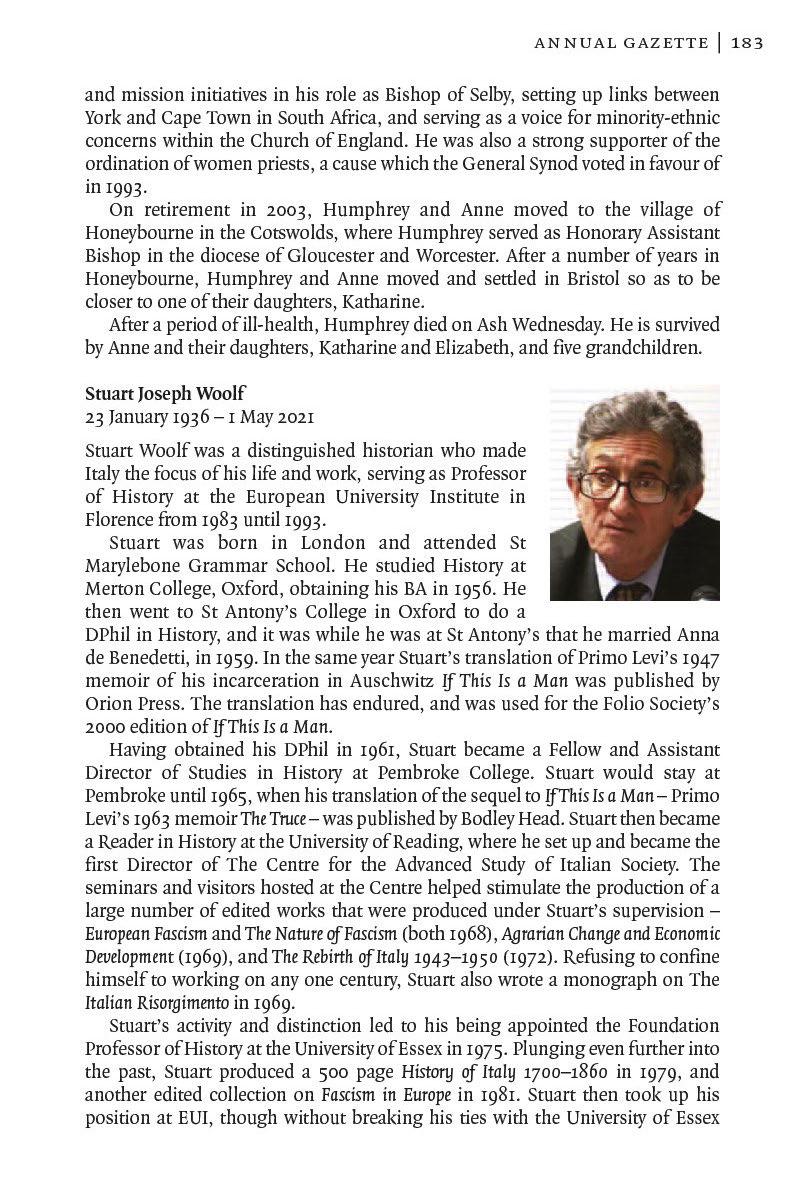
where he retained his Professorship. Stuart and Anna settled in the village of Settignano, just northeast of Florence. From there, Stuart not only worked at the EUI, but also took up a teaching position at Ca’ Foscari, the University of Venice, observing that he was ‘living every Englishman’s dream’ by being able to work in both Florence and Venice. Stuart’s historical research interests continued to spread further and further outwards, and started to turn towards France, with a co-authored work on State and Statistics in France 1789–1815 coming out in 1984, an edited collection on Domestic Strategies: Work and Family in France and Italy in 1991, and a major work on Napoleon’s Integration of Europe the same year. Stuart also produced a similarly comprehensive book on The Poor in Western Europe in the Eighteenth and Nineteenth Centuries in 1986.
After leaving the EUI in 1993, Stuart finished his career holding the dual position of Research Professor at the University of Essex, and Professor of Contemporary History at Ca’ Foscari, where he created the European Doctorate in the Social History of Europe and the Mediterranean. He rounded off his publication career with a history of the Aosta Valley (1995), and – perhaps anticipating the turn European politics was about to take – a reader on Nationalism in Europe (1996).
Stuart is survived by his wife Anna and their daughter Deborah, and a generation of European historians who were either taught and supervised by Stuart, or helped and advised by him.
F. MEMBERS’ CORNER
